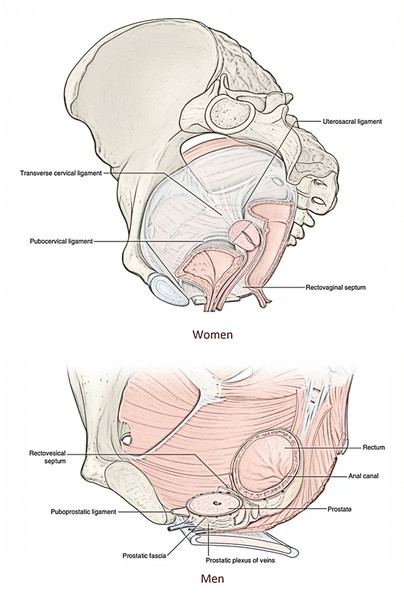The Pelvic Fascia is situated within 2 layers- parietal layer and visceral layer.

Pelvic Fascia
Parietal Layer of Pelvic Fascia
It’s the continuance of fascia transversalis of the anterior abdominal wall. In the pelvis, it’s referred by distinct names on the premise of structures it lines. All these are as follows:
- Obturator fascia: It’s a well-defined layer of fascia that covers the obturator internus muscle. It presents a linear thickening termed tendinous arch which gives origin to the levator ani muscle.
- Fascia covering piriformis: It’s a thin layer of fascia covering the piriformis. The sacral plexus is located between this fascia and piriformis muscle. The branches of the sacral plexus don’t pierce this fascia while passing out of the pelvis.
- The superior fascia of pelvic diaphragm: It covers the superior surface of the pelvic diaphragm.
Visceral Layer of Pelvic Fascia
It’s condensation of the loose areolar tissue around the extraperitoneal parts of the pelvic viscera and blood vessels. It’s free and thin, around distensible organs (example, urinary bladder) but thick around the non-distensible organs (example, prostate gland). Its condensations around the neurovascular structures create the ligaments of the pelvic organs which play an essential part in supporting the pelvic organs, like urinary bladder and uterus.
Pelvic Fascia in Women
In women, a rectovaginal septum separates the posterior surface of the vagina from the rectum. Condensations of fascia form ligaments that extend from the cervix to the anterior (pubocervical ligament), lateral (transverse cervical or cardinal ligament), and posterior (uterosacral ligament) pelvic walls.
These ligaments, together with the perineal membrane, the levator ani muscles, and the perineal body, are thought to stabilise the uterus in the pelvic cavity. The most important of these ligaments are the transverse cervical or cardinal ligaments, which extend laterally from each side of the cervix and vaginal vault to the related pelvic wall.
Pelvic Fascia in Men
In men, a condensation of fascia around the anterior and lateral region of the prostate (prostatic fascia) contains and surrounds the prostatic plexus of veins and is continuous posteriorly with the rectovesical septum, which separates the posterior surface of the prostate and base of the bladder from the rectum.

 (64 votes, average: 4.47 out of 5)
(64 votes, average: 4.47 out of 5)